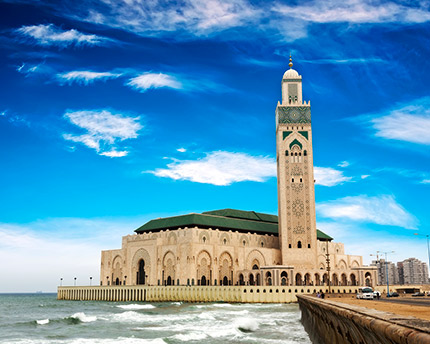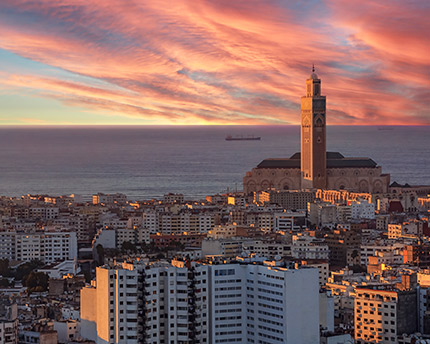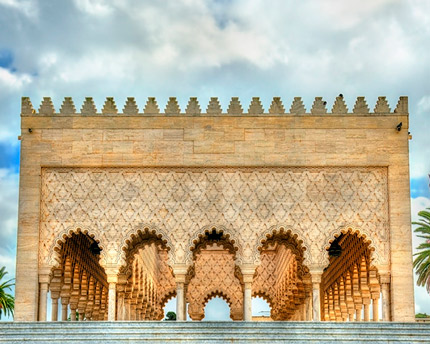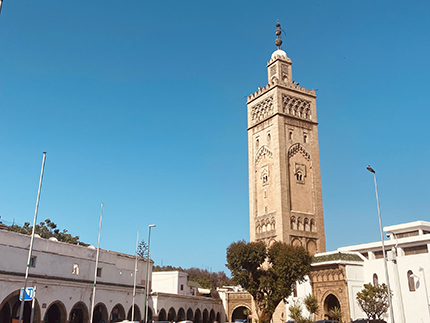On the shores of the Atlantic Ocean, Casablanca is Morocco’s biggest city, and the most populous (with around 4 million inhabitants). It is home to the country’s biggest port, as well as being the main financial and business centre of both Morocco and the northwest of Africa. But that’s not all.
A buzzing, cosmopolitan city, Casablanca’s roots stretch far back in history, to the eleventh century when the old city of Anfa was founded. It is characterised by the remarkable zest typical of African cities in the twenty-first century. The old mosques are interspersed with modern buildings housing business offices, the shopping centres are scattered with souks, an old café stands next to an haute cuisine restaurant… modernity and tradition make for a cocktail of experiences that it would be a crying shame to miss.
In fact, beyond the tired cliché of the classic Hollywood blockbuster, Casablanca is a fascinating city reflecting every facet of Morocco, from the most traditional to the most eclectic and avant-garde, and to tour the city is to discover and enjoy sights that evoke a sense of wonder.
Hassan II Mosque: Casablanca’s great icon
With its soaring, 200 m-tall minaret and its location on the shore as if it were a huge lighthouse, the Hassan II Mosque is one of Casablanca’s undisputed icons and, of course, one of its not-to-be-missed sights.
The mosque opened in 1993, and is one of the five biggest mosques in the world — its prayer hall can hold up to 25,000 people. It is a stunning architectural achievement. With its frescoes and zelliges (handmade ceramic tiles), its decorative elements in carved and painted wood, its countless stuccoes and arabesques with their geometric or calligraphic motifs… the place is a veritable hymn to the dedicated work of Moroccan master craftsmen.
In addition, the Hassan II mosque is the only one open to non-Muslims in the whole of Morocco, although access is only allowed for guided tours. Admission is €12 per person, and visits take place every day in accordance with a set timetable.
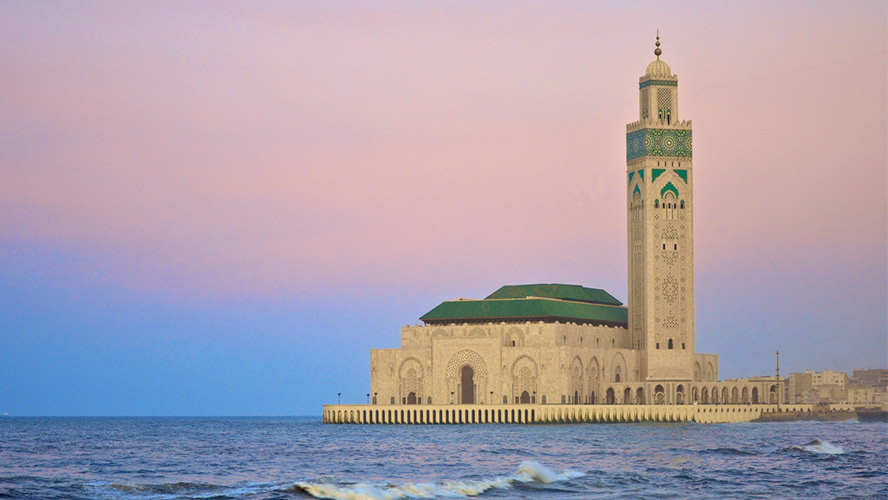
La Corniche, the city with sea views
Running along the greater part of the city’s Atlantic shoreline, this long seafront promenade offers a range of experiences to suit all tastes, from beaches where you can go surfing to some of Casablanca’s best restaurants and nightclubs.
La Corniche could be said to start in the north, on the small peninsula of El Hank crowned by its historic lighthouse; it continues southwards as far as the beach of Ain Diab. However, the city continues to grow, and in recent years, La Corniche is regarded as including the completely renewed stretch between the lighthouse and the Hassan II Mosque whilst at the other end, it covers the whole area occupied by the vast Morocco Mall and the Madame Choual beach. In any case, any visit to the city must include a tour (whether on foot, on a bicycle or on skates) along this lively stretch of coastline.
The Hassan II Mosque itself, the previously mentioned El Hank lighthouse, the restaurants, shops, beach clubs and nightclubs of Lalla Meryem and Aïn Diab, and the exclusive Morocco Mall shopping centre are just a few of the attractions to be found on this kilometre-long seafront promenade, frequented day and night by both tourists and inhabitants of Casablanca. The sunsets here are amazing.
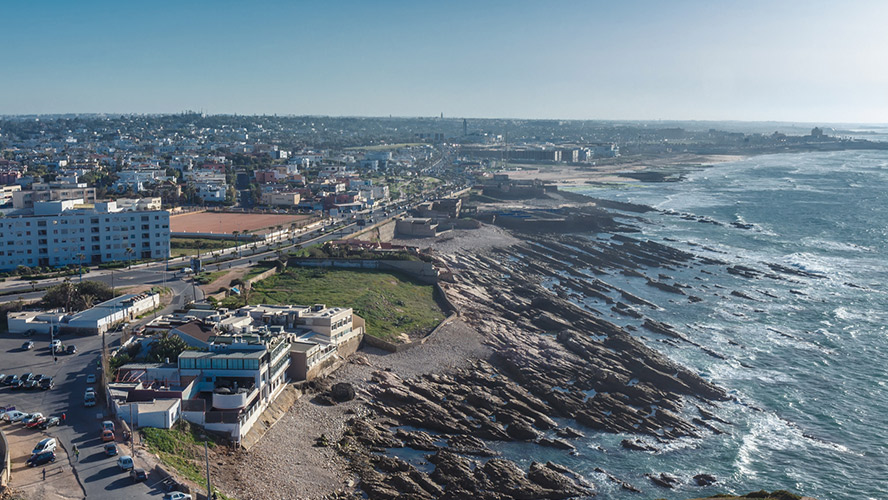
Casablanca’s Medina, heritage and tradition
A testament to Morocco’s rich Arab and Islamic heritage, Casablanca’s old Medina is, naturally, one of the city’s great attractions. While Casablanca is not as old as Fez or Marrakesh, visitors can nonetheless feel the unmistakeable magic of the Arab and Maghrebi medinas with their surrounding walls, labyrinthine streets, and all kinds of little cafés and shops.
In contrast to the medinas of the Imperial Cities (Marrakesh, Fez, Rabat and Meknes) dating back hundreds of years which are steeped in the aroma of spices, and which exude that characteristic exotic ambience that is at times just a little too touristy, Casablanca’s Medina is rather a place where local people carry on their day-to-day business. Here you will find shops selling basic products, along with workshops, cafés and tea shops, the odd shop selling craft items, and picturesque corners, including Sidi Bousmara Square, Jamaa Chleuh mosque, and Ettedgui Synagogue. All this means that Casablanca’s Medina is well worth a visit precisely to see vestiges of the original Morocco, closely bound up with heritage and tradition.
In the far north, very near to the Medina’s Heritage Interpretation Centre, are the remains of La Sqala, ancient fortifications built to protect the city during the eighteenth century, which still watch over the port (although they’ve now been turned into a famous restaurant serving traditional cuisine).
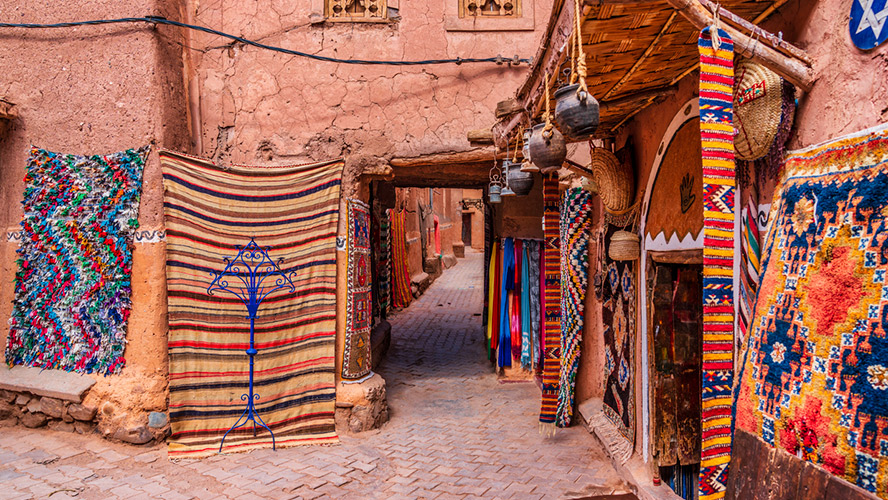
The Royal Palace, the jewel in the crown
This remarkable example of the finest Islamic architecture is one of so many royal residences to be found in practically every large city in the country, and although you can only see the outside of the building, its exceptional architecture makes it well worth visiting — especially if combined with a visit to nearby Quartier Habous or to the historic Mahkama du Pacha palace, also very close to the Royal Palace.
This great complex, construction of which dates from the 1920s — around the same time as the New Medina — has enormous, Mediterranean-style gardens, all kinds of spaces used for royal receptions and formal events, and the living quarters of the monarch and the royal family. The main façade, with its huge, richly-decorated arches and doors, is practically the only part that can be appreciated from outside.
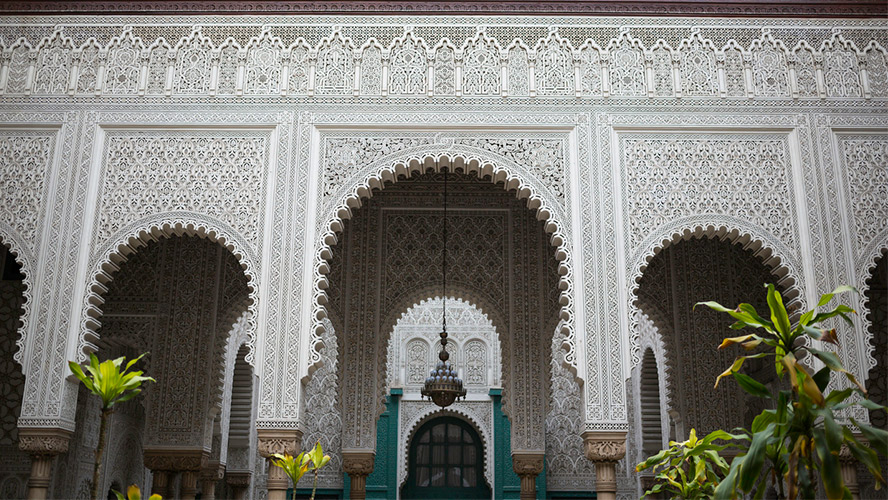
Rick’s Café — from the silver screen to reality
Curiously, not a single second of the famous 1942 film was shot in Casablanca (all the interior scenery was set up in the Warner Bros. studios in Burbank, California, and the external footage was filmed in other parts of Los Angeles and in the state of Arizona). However, the famous café of fiction found its way into the real world when, in 2004, this replica opened its doors. It was designed to bring to life, as faithfully as possible, that special bar ruled over by the charismatic and cynical Rick Blaine, played by the legendary actor, Humphrey Bogart.
Nestled against the walls of the Medina, and housed in an old, traditional mansion which has been carefully restored and redecorated, Rick’s Café offers good food, good cocktails and, of course, good live music — but, above all else, it offers an amazing journey into the heart of one of the all-time cinema greats. A magical place.
United Nations Square, a bridge between yesterday and today
The point where the old Medina meets the new city, this square is one of the busiest nerve centres of the ‘White City’. And although it has undergone various transformations over time, from old souk to a symbol of the colonial city landscape, nowadays this spot is a busy meeting point in the heart of Casablanca — a mixture of offices, fast-food outlets, shops and traditional cafés, as well as being an important stop on the city’s tram network.
The famous BMCI building, which dates from the mid twentieth century; the classic Excelsior Hotel, built in a neo-Moorish style; the strange dome known as ‘Kora Ardia’ (World Globe), designed by the architect Jean-François Zevaco, and the reproduction of the old Clock Tower from colonial times, are just some of the iconic buildings that can be seen in this popular square. The subject of recent renovations, the square is yet another of those points where the most traditional aspect of Casablanca meets the city’s more modern side.
Mohammed V Square, the heart of ‘European’ Casablanca
Just a few streets away from United Nations Square is another important urban space, one that was designed to become in a sense the heart of the new ‘European’ city. Built during the years of the French Protectorate, and based on the great plan drawn up by the French Governor Louis Hubert Lyautey and the architects Henri Prost and Joseph Marrast, this great square is a remarkable blend of traditional and modern elements — or, to put it another way, a reflection of the city itself.
Inspired by Stanislas Square in the French city of Nancy (the birthplace of Marshal Lyautey), Mohammed V Square is flanked by important public administrative buildings: the Prefecture, the Government Regional Delegation (Wilaya de Casablanca-Settat), the French Consulate, the Post office, the State Bank of Morocco, the Palace of Justice, and so on. All these are genuine architectural gems, a unique blend of Spanish-Moorish and Art Déco styles. And the square’s crowning glory is a great, circular fountain that regularly delights passers-by with an exquisite show featuring streams of water and music.
In addition, to cement the ties between the past and the future, there stands on the far west side of the square the spectacular Grand Theatre of Casablanca, a modern centre for the performing arts, designed by the French architect Christian de Portzamparc (awarded the Pritzker prize in 1994), which is due to open its doors at the end of 2022.
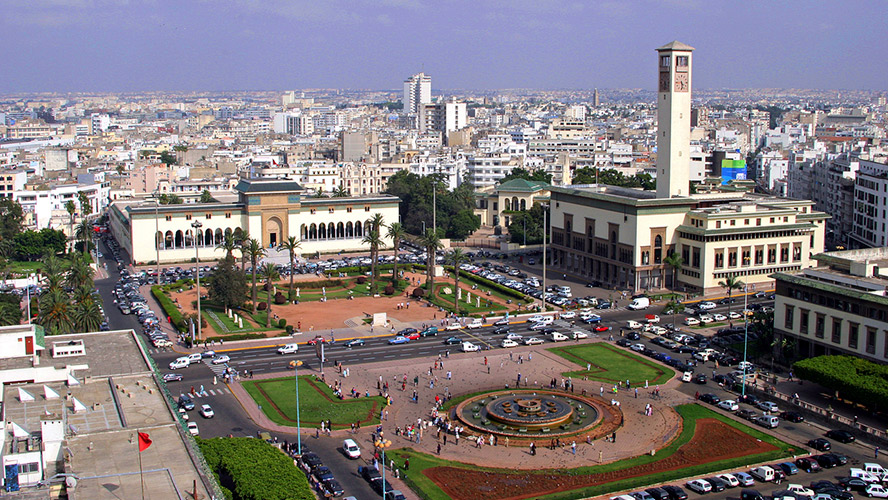
Quartier Habous, the New Medina
Also built during the period of the French Protectorate, this attractive neighbourhood is known as the New Medina and, like so many projects of that time, it represents a remarkable blend of Moorish or Andalusian and Art Déco architectural styles. Seeing its narrow streets, tiny squares, fountains, arcades and stone doorways, its mosque and its Arab baths, it is hard to believe that this place that follows all the rules for building a genuine medina was only built in the first half of the twentieth century.
Walking around its cobbled streets, you will come across little souvenir shops, stalls selling crafts, jewellers and other traditional shops, as well as those catering for the tourists. In any case, this is a highly enjoyable walk through one of the city’s most emblematic areas, a good place to discover the huge cultural value of the extraordinary work of Moroccan master craftsmen.
Arab League Park, Casablanca’s green lung
Designed in 1918 by the architect Albert Laprade, and inspired by the great urban parks of Paris, this vast green space (occupying almost 30 hectares and recently upgraded), is one of the most pleasant places in the city to stroll and enjoy something that has become very scarce in this day and age — time to oneself. The park is a genuine oasis just a stone’s throw from Mohammed V Square; it is home to tall palm trees, fountains, little cafés, play areas, sports areas, and more.
And it is precisely the kiosks and cafés, along with the sports facilities and walks in the shade of the trees, that enable visitors to get a real feel for the city itself; the Arab League park is a living place, very popular with the locals, which tempts one to explore and enjoy the most authentic side of Casablanca.
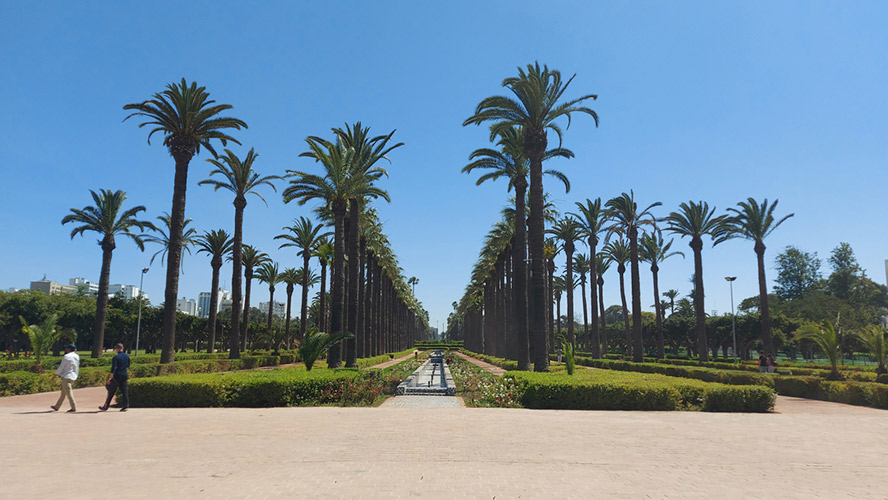
Morocco Mall, the most modern face of Casablanca
If the Old Medina is an example of the more traditional city, the vast and exclusive Morocco Mall shopping centre, with over 350 shops ranging from big international brands to the latest technology, is clearly the modern face of Casablanca. Interestingly, within the same centre, a small souk has been created, offering the work of around fifty carefully selected craftsmen, by way of a tribute to local cultural heritage. At the end of the day, one can only conclude that the ‘White City’ is indeed a blend of the traditional and modern.
Located at the far southern end of La Corniche, between Ain Diab and Madame Choual beach, we can also find all kinds of gastronomic options, an aquarium, an IMAX 3D cinema, an indoor amusement park and anice-skating rink, among other attractions. In addition, the huge outdoor fountain, with its shows featuring streams of water, lights and sound (at 6,000 m² is the third largest fountain of this type in the world, after the Bellagio fountain in Las Vegas, and the Burj Khalifa in Dubai), making this a truly amazing place and one that will entertain the whole family.
The Cathedral of Casablanca, an architectural treasure
Nestled in the north-western corner of the Arab League Park, the Old Cathedral of the Sacred Heart is a unique edifice in the Neo-Gothic style with Art Déco elements and Andalusian touches; it was built during the first half of the twentieth century. Although it was used as a Catholic church during the years of the French Protectorate, it never was in fact a cathedral. Moreover, after Morocco achieved independence in in 1956, the church was deconsecrated and converted into a cultural centre.
Nowadays, this architectural gem is as much an extraordinary witness to the rich history of the city as it is a star of the local artistic and cultural calendar, as it frequently hosts exhibitions, concerts, and all kinds of special events.
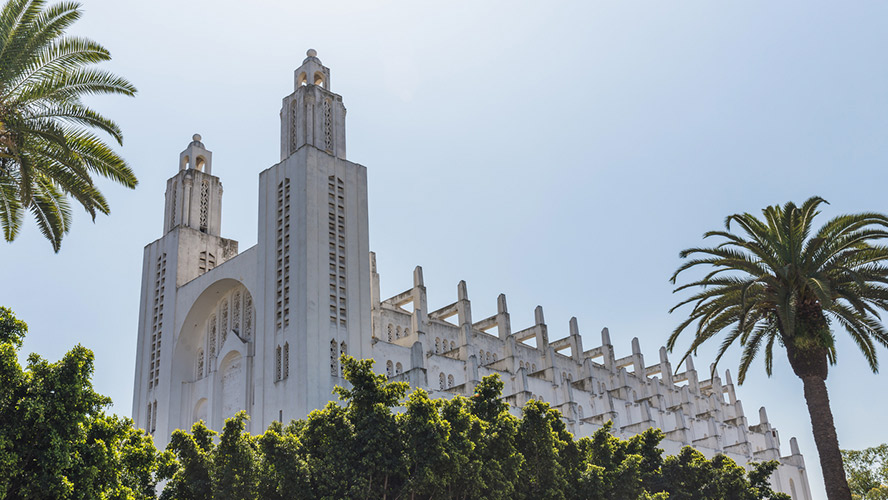
Where to eat in Casablanca
Not that you would expect otherwise, but Casablanca is also an earthly paradise for foodies, as its rich culinary offer ranges from little traditional cafés to top-class restaurants offering the most sophisticated local and international cuisine. And to show you, here’s a button to click.
- NKOA — A mere stone’s throw from the Arab League Park, this restaurant offers a remarkable fusion of local flavours and the finest international cuisine. Creative cooking in a relaxed yet stylish ambience: Casablanca as its most cosmopolitan.
- La Closerie — For real gourmets, this typical French brasserie offers rich flavours and excellent fresh seafood, accompanied by the finest wines, a few streets away from the historic Mohammed V Stadium.
- Le Cuistot Traditionnel — On one side of Mohammed V Square, this is one of the best restaurants if you want to discover the true taste of traditional Moroccan cooking. Tagines, cous-cous, lamb ribs, fresh fish, mint tea… The décor adds to the charm of this classic Casablanca restaurant.
- Rick’s Café — A replica of the fictional café featured in the famous film starring Bogart and Bergman, this friendly restaurant is perfect for those who love nostalgia and classic films. Of course, there is live music… “Play it again, Sam.”
Where to stay in Casablanca
Without question, the ideal options for an unforgettable stay in the ‘White City’ are the Barceló Casablanca hotel and the Barceló Anfa Casablanca , both located on the central Boulevard d’Anfa — quite close to one another — and just metres away from the city’s main attractions.
The first is a modern 4* hotel with stunning views and the second an amazing Art Déco 5*. Both have a pleasant, contemporary design, fully equipped guest rooms and thoughtfully prepared cuisine, reflecting that balance between tradition and modernity that makes Casablanca such a special destination.





























































